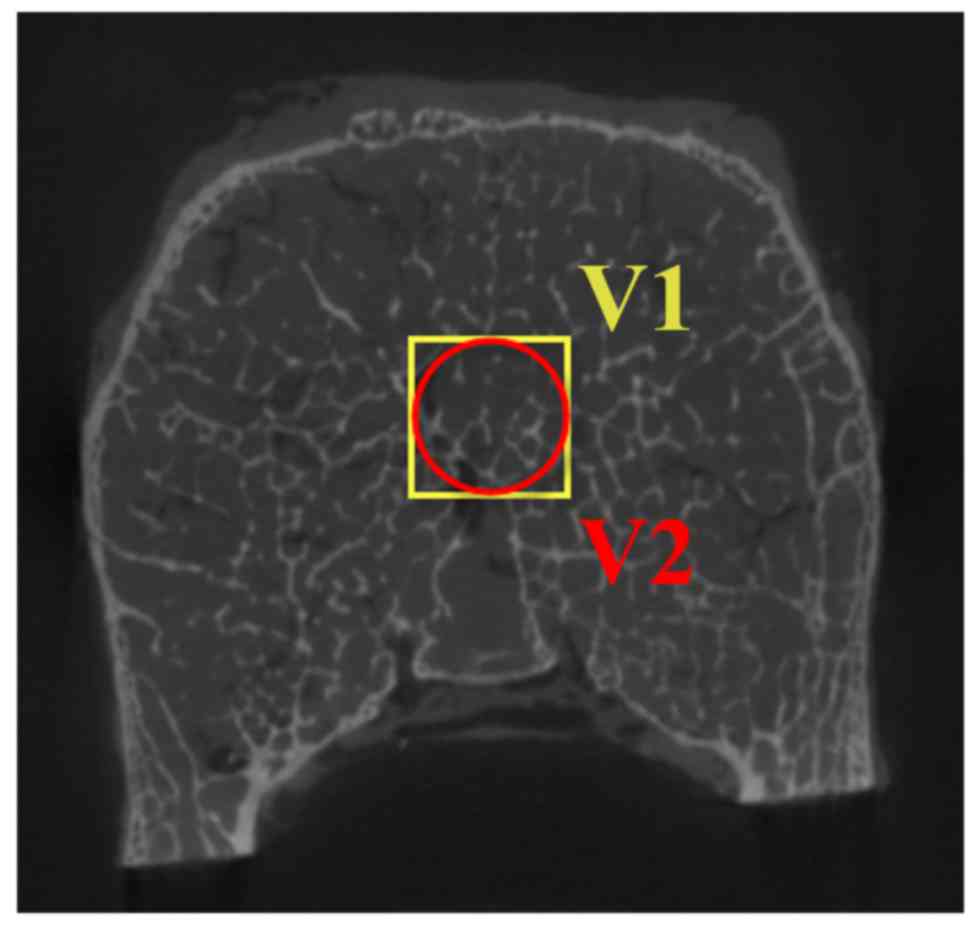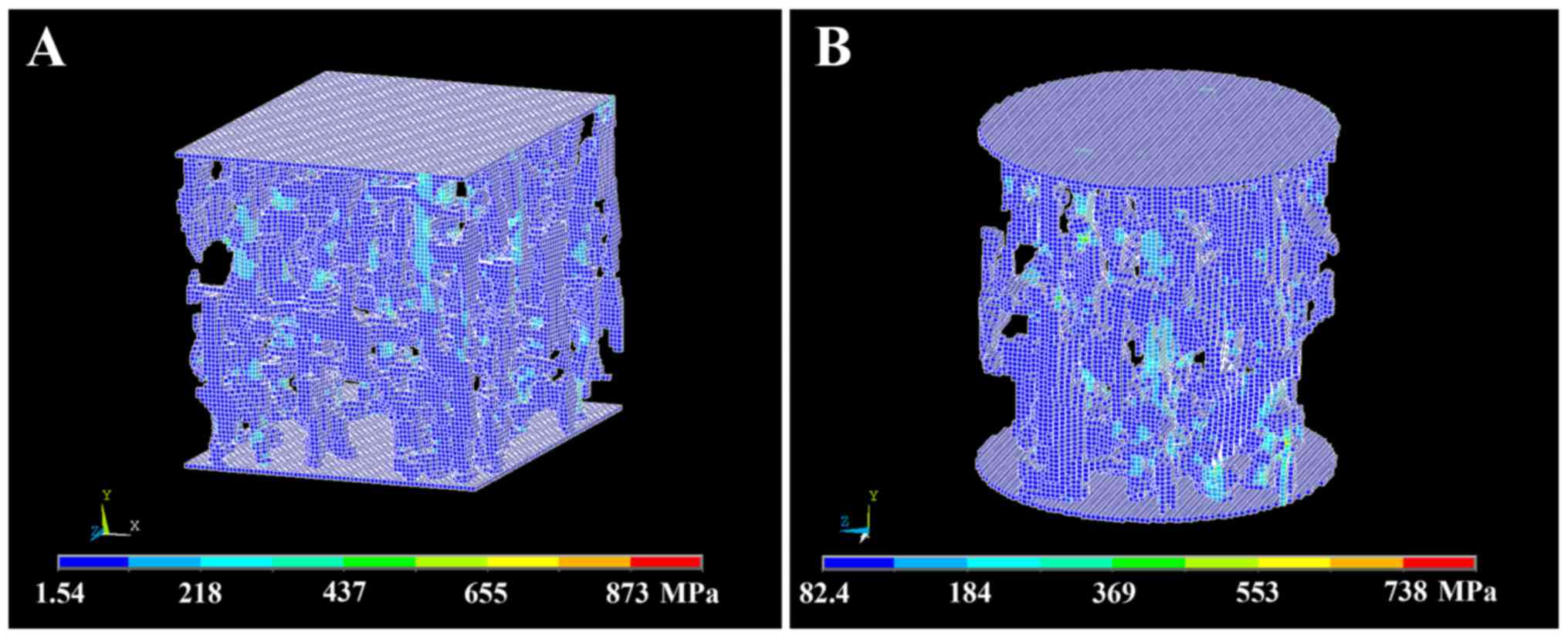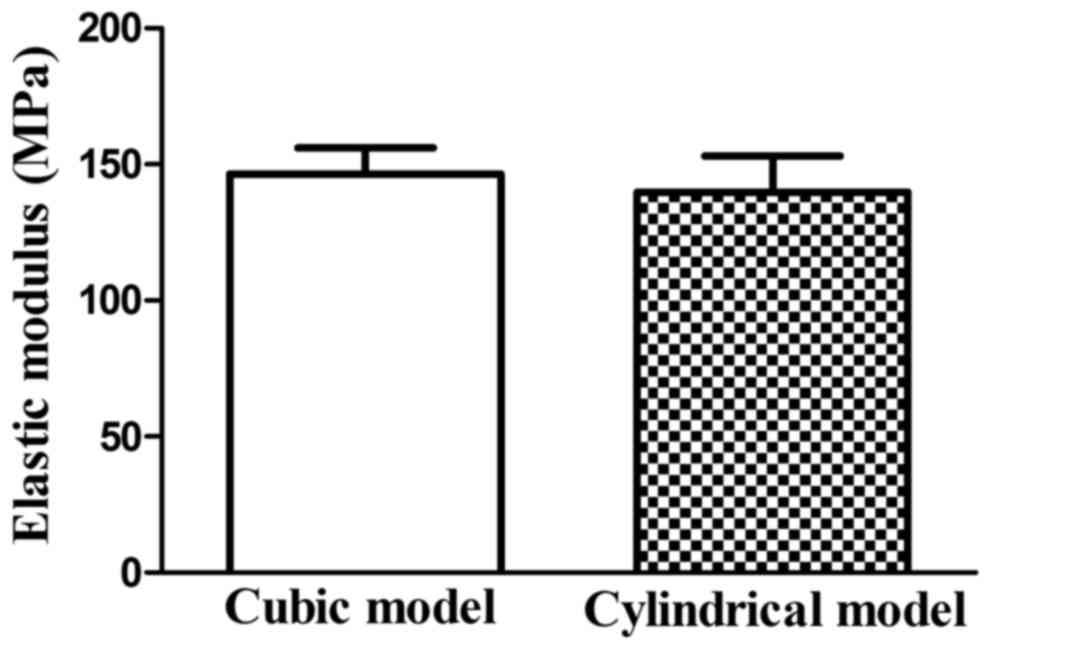|
1
|
Niebur GL, Feldstein MJ, Yuen JC, Chen TJ
and Keaveny TM: High-resolution finite element models with tissue
strength asymmetry accurately predict failure of trabecular bone. J
Biomech. 33:1575–1583. 2000. View Article : Google Scholar : PubMed/NCBI
|
|
2
|
Verhulp E, Van Rietbergen B, Muller R and
Huiskes R: Micro-finite element simulation of trabecular-bone
post-yield behaviour-effects of material model, element size and
type. Comput Methods Biomech Biomed Engin. 11:389–395. 2008.
View Article : Google Scholar : PubMed/NCBI
|
|
3
|
Wolfram U, Wilke HJ and Zysset PK: Valid
micro finite element models of vertebral trabecular bone can be
obtained using tissue properties measured with nanoindentation
under wet conditions. J Biomech. 43:1731–1737. 2010. View Article : Google Scholar : PubMed/NCBI
|
|
4
|
Chevalier Y, Pahr D, Allmer H, Charlebois
M and Zysset P: Validation of a voxel-based FE method for
prediction of the uniaxial apparent modulus of human trabecular
bone using macroscopic mechanical tests and nanoindentation. J
Biomech. 40:3333–3340. 2007. View Article : Google Scholar : PubMed/NCBI
|
|
5
|
Hambli R: Apparent damage accumulation in
cancellous bone using neural networks. J Mech Behav Biomed Mater.
4:868–878. 2011. View Article : Google Scholar : PubMed/NCBI
|
|
6
|
Gross T, Pahr DH and Zysset PK:
Morphology-elasticity relationships using decreasing fabric
information of human trabecular bone from three major anatomical
locations. Biomech Model Mechanobiol. 12:793–800. 2013. View Article : Google Scholar : PubMed/NCBI
|
|
7
|
Ulrich D, van Rietbergen B, Laib A and
Rüegsegger P: The ability of three-dimensional structural indices
to reflect mechanical aspects of trabecular bone. Bone. 25:55–60.
1999. View Article : Google Scholar : PubMed/NCBI
|
|
8
|
Bevill G, Eswaran SK, Farahmand F and
Keaveny TM: The influence of boundary conditions and loading mode
on high-resolution finite element-computed trabecular tissue
properties. Bone. 44:573–578. 2009. View Article : Google Scholar : PubMed/NCBI
|
|
9
|
Otsu N: A threshold selection method from
gray-level histograms. IEEE Trans Syst Man Cybern. 9:62–66. 1979.
View Article : Google Scholar
|
|
10
|
Ruffoni D, Wirth AJ, Steiner JA, Parkinson
IH, Müller R and van Lenthe GH: The different contributions of
cortical and trabecular bone to implant anchorage in a human
vertebra. Bone. 50:733–738. 2012. View Article : Google Scholar : PubMed/NCBI
|
|
11
|
Ulrich D, van Rietbergen B, Weinans H and
Rüegsegger P: Finite element analysis of trabecular bone structure:
A comparison of image-based meshing techniques. J Biomech.
31:1187–1192. 1998. View Article : Google Scholar : PubMed/NCBI
|
|
12
|
Kamaya M: Stress-strain curve estimation
procedures for stainless steels based on yield and ultimate
strengths. Eng Fract Mech. 127:194–210. 2014. View Article : Google Scholar
|
|
13
|
Hambli R: Micro-CT finite element model
and experimental validation of trabecular bone damage and fracture.
Bone. 56:363–374. 2013. View Article : Google Scholar : PubMed/NCBI
|
|
14
|
Cowin SC: Bone mechanics handbook. 2nd.
Boca Raton: CRC Press; 2001
|
|
15
|
Hou FJ, Lang SM, Hoshaw SJ, Reimann DA and
Fyhrie DP: Human vertebral body apparent and hard tissue stiffness.
J Biomech. 31:1009–1015. 1998. View Article : Google Scholar : PubMed/NCBI
|
|
16
|
van Rietbergen B and Ito K: A survey of
micro-finite element analysis for clinical assessment of bone
strength: The first decade. J Biomech. 48:832–841. 2015. View Article : Google Scholar : PubMed/NCBI
|
|
17
|
Kim DG, Hunt CA, Zauel R, Fyhrie DP and
Yeni YN: The effect of regional variations of the trabecular bone
properties on the compressive strength of human vertebral bodies.
Ann Biomed Eng. 35:1907–1913. 2007. View Article : Google Scholar : PubMed/NCBI
|
|
18
|
Aiyangar AK, Vivanco J, Au AG, Anderson
PA, Smith EL and Ploeg HL: Dependence of anisotropy of human lumbar
vertebral trabecular bone on quantitative computed tomography-based
apparent density. J Biomech Eng. 136:0910032014.PubMed/NCBI
|
|
19
|
Depalle B, Chapurlat R, Walter-Le-Berre H,
Bou-Saïd B and Follet H: Finite element dependence of stress
evaluation for human trabecular bone. J Mech Behav Biomed Mater.
18:200–212. 2013. View Article : Google Scholar : PubMed/NCBI
|
|
20
|
Kim DG, Christopherson GT, Dong XN, Fyhrie
DP and Yeni YN: The effect of microcomputed tomography scanning and
reconstruction voxel size on the accuracy of stereological
measurements in human cancellous bone. Bone. 35:1375–1382. 2004.
View Article : Google Scholar : PubMed/NCBI
|
|
21
|
Maloul A, Fialkov J and Whyne C: The
impact of voxel size-based inaccuracies on the mechanical behavior
of thin bone structures. Ann Biomed Eng. 39:1092–1100. 2011.
View Article : Google Scholar : PubMed/NCBI
|
|
22
|
Yeni YN, Christopherson GT, Dong XN, Kim
DG and Fyhrie DP: Effect of microcomputed tomography voxel size on
the finite element model accuracy for human cancellous bone. J
Biomech Eng. 127:1–8. 2005. View Article : Google Scholar : PubMed/NCBI
|
|
23
|
Bauer JS, Sidorenko I, Mueller D, Baum T,
Issever AS, Eckstein F, Rummeny EJ, Link TM and Raeth CW:
Prediction of bone strength by µCT and MDCT-based
finite-element-models: How much spatial resolution is needed? Eur J
Radiol. 83:e36–e42. 2014. View Article : Google Scholar : PubMed/NCBI
|
|
24
|
Isaksson H, Töyräs J, Hakulinen M, Aula
AS, Tamminen I, Julkunen P, Kröger H and Jurvelin JS: Structural
parameters of normal and osteoporotic human trabecular bone are
affected differently by microCT image resolution. Osteoporos Int.
22:167–177. 2011. View Article : Google Scholar : PubMed/NCBI
|
|
25
|
Niebur GL, Yuen JC, Hsia AC and Keaveny
TM: Convergence behavior of high-resolution finite element models
of trabecular bone. J Biomech Eng. 121:629–635. 1999. View Article : Google Scholar : PubMed/NCBI
|
|
26
|
Pahr DH and Zysset PK: Influence of
boundary conditions on computed apparent elastic properties of
cancellous bone. Biomech Model Mechanobiol. 7:463–476. 2008.
View Article : Google Scholar : PubMed/NCBI
|
|
27
|
Yan YB, Qi W, Wang J, Liu LF, Teo EC,
Tianxia Q, Ba JJ and Lei W: Relationship between architectural
parameters and sample volume of human cancellous bone in micro-CT
scanning. Med Eng Phys. 33:764–769. 2011. View Article : Google Scholar : PubMed/NCBI
|
|
28
|
Wang Y, Owoc JS, Boyd SK, Videman T and
Battié MC: Regional variations in trabecular architecture of the
lumbar vertebra: Associations with age, disc degeneration and disc
space narrowing. Bone. 56:249–254. 2013. View Article : Google Scholar : PubMed/NCBI
|
|
29
|
Wegrzyn J, Roux JP, Arlot ME, Boutroy S,
Vilayphiou N, Guyen O, Delmas PD, Chapurlat R and Bouxsein ML: Role
of trabecular microarchitecture and its heterogeneity parameters in
the mechanical behavior of ex vivo human L3 vertebrae. J Bone Miner
Res. 25:2324–2331. 2010. View
Article : Google Scholar : PubMed/NCBI
|
|
30
|
Chen H, Shoumura S, Emura S and Bunai Y:
Regional variations of vertebral trabecular bone microstructure
with age and gender. Osteoporos Int. 19:1473–1483. 2008. View Article : Google Scholar : PubMed/NCBI
|
|
31
|
Hulme PA, Boyd SK and Ferguson SJ:
Regional variation in vertebral bone morphology and its
contribution to vertebral fracture strength. Bone. 41:946–957.
2007. View Article : Google Scholar : PubMed/NCBI
|
|
32
|
Parkinson IH, Badiei A, Stauber M,
Codrington J, Müller R and Fazzalari NL: Vertebral body bone
strength: The contribution of individual trabecular element
morphology. Osteoporos Int. 23:1957–1965. 2012. View Article : Google Scholar : PubMed/NCBI
|
|
33
|
Lü L, Meng G, Gong H, Zhu D, Gao J and Fan
Y: Tissue level microstructure and mechanical properties of the
femoral head in the proximal femur of fracture patients. Acta Mech
Sinica. 31:259–267. 2015. View Article : Google Scholar
|
|
34
|
Hildebrand T, Laib A, Müller R, Dequeker J
and Rüegsegger P: Direct three-dimensional morphometric analysis of
human cancellous bone: Microstructural data from spine, femur,
iliac crest, and calcaneus. J Bone Miner Res. 14:1167–1174. 1999.
View Article : Google Scholar : PubMed/NCBI
|
|
35
|
Eckstein F, Matsuura M, Kuhn V, Priemel M,
Müller R, Link TM and Lochmüller EM: Sex differences of human
trabecular bone microstructure in aging are site-dependent. J Bone
Miner Res. 22:817–824. 2007. View Article : Google Scholar : PubMed/NCBI
|

















